There is a high degree of consensus among the healthcare community about the benefits that the adoption of solutions based on Advanced Analytics, Machine Learning and Artificial Intelligence will bring to their processes and operations. According to industry specialists, these solutions will improve diagnoses, prevent negative episodes and increase the efficiency of resources.
Likewise, the COVID19 crisis has added pressure on the need to innovate. The study “Cigna COVID-19 Global Impact” has discovered that 65% of Spaniards would like to adopt telemedicine in the future, reaching 73% in UAE.
However, besides the difficulties involved in the implementation of new solutions in any industry (read these data from the Telecommunications vertical, mention of the “proof of concept purgatory” included), we must add the particularities of the Healthcare sector and its organizational, regulatory, technical and market barriers.
In general, the success of a Digital Transformation initiative is linked to quick wins, which, although they do not exploit all the value of the innovation, do contribute to creating the confidence and time necessary in the process.
From nothing to something in times of pandemic.
As a result of our offer of help during the first wave of the pandemic, we received a request from the managers of two hospitals in Peru who needed a quick solution to calculate the impact that postponing appointments with non-COVID patients had on their resource usage and planning.
During that situation, COVID patients had priority in the allocation of resources, which led them to have to make decisions about which non-COVID patients to take care of and how to use the available resources based on different de-escalation scenarios. And back then, it this planning was urgent.
The situation was not trivial. Certain vaccines need to be administered before a certain age in order not to lose their effectiveness; certain chronic patients needed periodic monitoring to detect any variation in their condition.
In little more than a month from the beginning of the conversations, baobab developed a very simple application that given the resources used by each appointment according to its type and specialty, the priority of each appointment, the available resources, the possibility of using telemedicine and a forecast of future appointments, returned the predicted evolution of the completed appointments and the waiting lists, which allowed the managers to evaluate the impact of the decisions they had to make.


Franco Peschiera, co-founder of baobab, led that project:
- Q: What does this project prove?
- A: This project is a quick win, a first step in the right direction. It is a small tool that helps the managers of these hospitals to make important decisions and also gives them the intuition of what it means to introduce new solutions in their operations and their strategy.
- Q: What are the next steps to improve the solution?
- A: This solution was urgent, so we delivered the minimum viable product to meet the client’s needs. In the future you may benefit from a little more sophistication, such as an appointment demand forecasting model considering, for example, seasonality, compulsory vaccination forecasts based on population age and other factors; a more detailed and sophisticated allocation of available resources that allows eliminating inefficiencies and making the most of the system’s capacity for the benefit of professionals and patients. A simulation model of the daily flow of people in the hospital can find hidden capacity problems in common services (for example: waiting rooms, admission, pharmacy among others).
- Q: What made this project successful?
- A: The key was in the speed of response and the customization of the application. A project in which the end users do not see or use anything until after many months carries a lot of risk. The important thing is to be able to have a working prototype as soon as possible and that it can then be quickly modified to adapt to the needs of the users.


